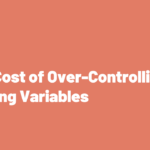Marketers love to talk about experiments. And experiments are great, but marketers who only focus on A/B tests and holdout studies are missing out on levers that can move the needle for their business.
So here’s our premise: the sharpest marketing organizations need to think in bets instead.
What is a marketing bet, really?
A marketing bet is any deliberate action taken to test an assumption about what drives growth for your business. That could mean running a holdout test, yes – but it could also mean bringing up spend in a high-performing channel, reallocating budget across channels, pausing an underperforming campaign entirely, or launching into a new platform.
It can sound like semantics but we think it’s a meaningful distinction: the broader your definition of a bet, the more opportunities you create to learn.
Some of these marketing bets are made to improve performance: “The model says TV might be more incremental than we thought – let’s test pulsing up spend.”
Others are about reducing uncertainty: “TikTok’s ROI is different across every attribution tool. Let’s go run an experiment and get more signal.”
Thinking in these terms is how you start unlocking new growth levers for your business and avoid falling into the “micro-optimization trap”, where your marketing day-to-day looks like tweaking the same channels you’ve been running for the last five years.
Why “thinking in bets” beats just running experiments
Thinking in bets breaks that cycle and brings forward more important questions: What actually moves our business? Where should we invest more? What assumptions are we basing our plan on?
It also helps you not get locked into designing statistically “perfect” experiments. Ideally, your marketing bets are rigorous and well-planned. But sometimes you need to work within constraints and just place bets where you can to start learning.
You can’t expect every bet to work. But you can expect them to teach you something. And over time, that learning compounds.
But where do you start? How should you prioritize which bet to place next?
How to prioritize marketing bets: impact × uncertainty × feasibility
Every marketing team has limited capacity and you don’t get to test everything. So, the question is: how do you choose the right bets? This is how we think about it here at Recast:
Step 1: quantify impact
We recommend you start by listing your top 3–5 marketing channels by current spend. These are the real levers.
The goal of placing marketing bets isn’t to get precise reads on small channels. It’s getting directionally correct on the big swings that actually move your business. Focus here first – if Connected TV is your biggest spend item, start there. Meta, Search… whichever makes up the biggest line items.
This might sound obvious, but you’d be surprised how many teams start by testing tiny channels where the impact will be marginal at best.
Step 2: identify uncertainty
Next, map where your performance signals are most shaky. Many marketers rely on attribution models that take events that already happened and assign credit after the fact. That backward-looking logic often disagrees with other signals, and that makes it a bet worth placing.
Look for channels where attribution tools conflict or where ROI estimates are different. If there’s uncertainty and your team lacks clarity – especially in an important channel – that’s a great opportunity to place a bet.
Step 3: assess feasibility (technical + political)
Finally, be brutally practical about what can actually launch. Sometimes the smartest bet is the one you can sell and ship.
For example, brand search is perfect for this. When you run a proper incrementality test, the difference is often crystal clear. Simple, interpretable tests like a holdout on branded search are a good way to build credibility internally and start building this testing muscle.
Step 4: score and prioritize
Then, a good way forward is to bring your bet ideas into a decision matrix or a weighted scoring rubric. For each prospective bet, score it on:
- Impact (scale by channel budget or expected lift),
- Uncertainty (how noisy or contradictory are current signals?),
- Feasibility (ease to run, interpret, and communicate).
Ideally, your highest priority bets should live where impact is large, uncertainty is high, and feasibility is realistic.
Make testing a system, not a one-off project
The best marketing organizations we work with don’t treat experimentation as a one-and-done exercise. They build what we call an incrementality system: a structured approach to generating hypotheses, running experiments, and using that information to continuously improve.
Different businesses will apply this process differently, but the core idea stays the same: instead of guessing, you’re creating a virtuous cycle of planning a test → running the experiment → validating the results → and optimizing spend accordingly – and then repeat.
Teams that do this well start compounding their learning. Each test builds on the last. Each reallocation improves the next.
Forget “stat sig”: decisions aren’t binary
Side note (but this is where many marketers get stuck.): once you’ve prioritized your highest-impact bets, interpreting the results correctly can be its own challenge.
We’ve seen teams treat statistical significance like a final verdict. p < 0.05? The test worked. p > 0.05? Trash it. We disagree.
In practice, statistical significance gets misused constantly in marketing. P-values get weaponized, and we hate when this “statistical gospel” makes teams not get value of a test they just ran.
A “non-significant” result doesn’t mean there’s no signal. It just means the signal is noisy. And noise can still be useful.
For example
- “The data suggests ROI is somewhere between 0x and 2.5x — and we can confidently rule out anything higher.”
- “The test shows CPA is likely above $250, even if we can’t pinpoint the exact value. That tells us lower CPAs aren’t supported by the data.”
The goal isn’t to run a clinical-trial-level statistical experiment. It’s to place better bets and get directional insight that drives smarter decisions.
TLDR:
- Stop thinking in terms of “experiments” – the best marketing bets include budget shifts, new channels, and campaign pauses that test strategic assumptions about growth.
- Prioritize your bets: focus on big-spend channels, identify where your current signals are noisiest, and choose bets that are both feasible and politically “winnable.”
- Track every bet, learn from noisy results, and build compound growth and intelligence through these repeatable learning loops.
- Don’t obsess over p-values – directional insights and confidence intervals are still useful decision-making tools if you know how to read them.



